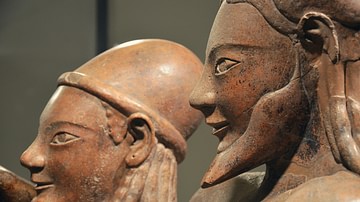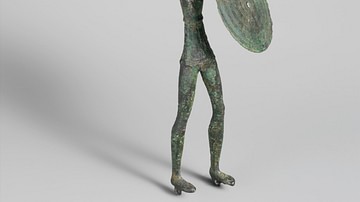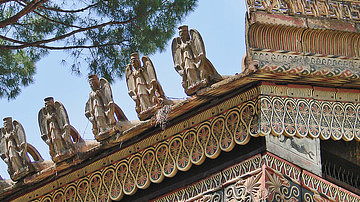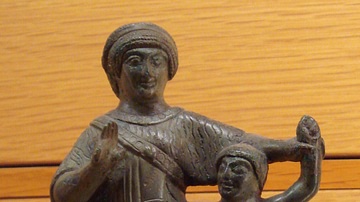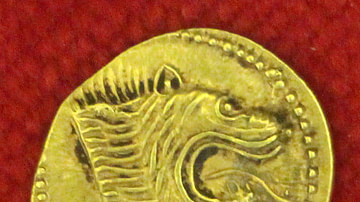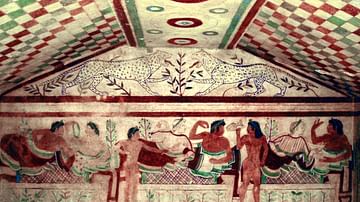The clothing of the ancient Etruscans, a civilization which flourished in central Italy between the 8th and 3rd century BCE, can be seen in many media of their art including wall paintings, bronze sculpture, stone relief carvings, and painted figures on terracotta funerary urns, as well as occasional descriptions by ancient foreign writers. The history and study of the Etruscan civilization have suffered in many areas due to the lack of firsthand texts and their ultimate cultural assimilation into the Roman world, but clothing is one subject where the Etruscans have an advantage over most ancient peoples. Clothing is perishable and even when it does survive, its original colouring does not, but with the Etruscans, we are fortunate in having the miraculously preserved wall paintings of their tombs which provide us with a unique opportunity to glimpse in glorious technicolour the flamboyant world of Etruscan fashion.
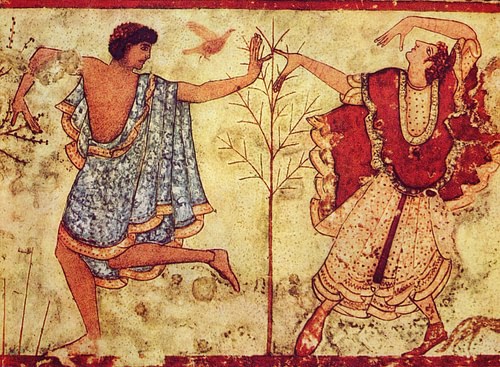
Origins & Development
Weaving was an important industry in most ancient cultures, and the Etruscans were no different. Finds of bronze tools such as loom weights, spools and spindles are evidence that the craft went back to the Villanovan culture, a precursor to the mature Etruscans, during the Iron Age in central Italy (1100-750 BCE). Wool weaving was first done in the private home on a small scale but not necessarily only by women as deposits of paraphernalia in male tombs suggests. As agriculture developed and natural resources such as metals were better exploited, communities prospered and a manufacturing class developed which could devote itself to the production of better quality daily goods. Clothing was amongst these, and the Etruscans became particularly noted in antiquity for their production of linen used for books and clothing. Wool, more easily dyed and heavier, was used for outer garments while inner ones used plain linen. Animal hides and, much more rarely, cotton, might also have been used for clothing.
The influence of Ionia and the Near East on Etruscan culture was also seen in clothing, especially in pointed footwear, soft conical hats, and generally highly decorative patterns. Then, as contact with Greece and Magna Graecia increased via trade, so too did the influence on fashion. Long dresses secured at the shoulder by a brooch, light shawls, a long, simple white cloak (himation) with a red or black border, and a short-sleeved tunic (chiton) made from linen are all seen in Etruscan tomb paintings, especially at coastal sites where the contact with the Greek world was more frequent.
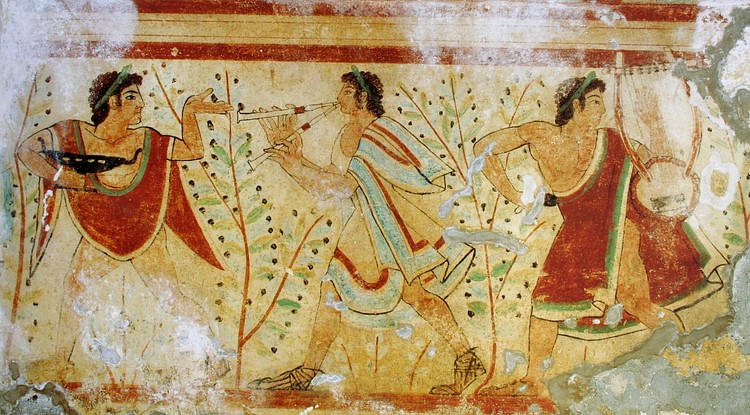
The most striking feature of Etruscan clothing, both for men and women, is the wide range of colours and cuts used. One must be cautious and remember that the costumes of musicians, dancers, and even diners in wall paintings may have been depicted wearing their ceremonial finery, and this does not necessarily reflect everyday clothing for themselves or people in general. Still, there is no doubt that the clothes for Etruria's wealthy citizens (whose tombs were the only ones to be painted) and their slaves were bold in colour, design, and variety, reflecting both the more varied climate of central Italy compared to other parts of the Mediterranean and a more flamboyant taste than seen in contemporary cultures or what we know of them. Such was the contrast with the more austere Greek and Roman taste in fashion that Posidonius, the Greek scholar, famously noted that the extravagant clothing of Etruscan entertainers was "more beautiful than is fitting for slaves" (Heurgon, 172).
Women's Clothes
Bright colours abound with cloaks, bodices, and short jackets in red, royal blue, pale green, orange, yellow, and sometimes with bold horizontal stripes, vertical stripes, or polka dots. Dresses are sleeveless, short-sleeved, and long-sleeved with varying hem lengths, sometimes with an arch cut over the feet. Outer garments are often sumptuously embroidered with decorative motifs such as the lady in the Tomb of Francesca Giustiniani at Tarquinia whose orange-pink cloak is speckled with dots and stars. The dark red cloak of a lady in the Tomb of the Lionesses at Tarquinia (530-520 BCE) is decorated with embroidered flowers and has blue additions in front which hang like wide straps. Dancers in tombs at Chiusi have the same type of hanging lapels or revers in front. The hems of garments sometimes have tasselled or otherwise decorative fringes.
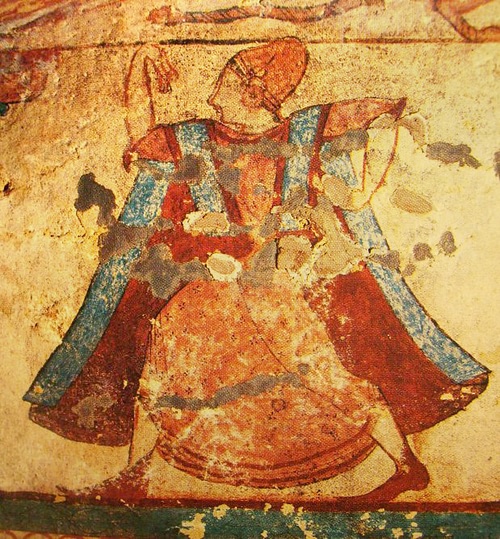
Clothes are extravagantly cut and in stark contrast to the austere perpendicular lines of Greek clothing. Sleeves billow at the cuffs, as do trousers with flared bell-bottoms, a silhouette which is only accentuated by tight belted waistlines. Cloaks and wrap-around mantles with a low round neckline appear on both men and women and seem to be made of a thick material (as they would have to be to protect in cool winter weather) with heavy folds. They have a different colour lining from the exterior and often have coloured borders on both sides.
Men's Clothes
We have seen that women's clothes could be colourful with embroidered decoration, and men's clothes were sometimes no different. The magistrate or auspicium (reader of omens) known as Vel Saties from the Francois Tomb at Vulci (late 4th century BCE) is an example. He wears a striking dark blue embroidered cloak which has several nude male figures who are dancing while carrying shields in a slightly garish concoction worthy of a 21st-century CE Dolce & Gabbana creation. Another commonly depicted item is the short tunic or jerkin (tunica), worn with a belt. Finally, priests have a costume of their own: a sheepskin worn inside out over a simple sleeved tunic which hangs down to the boots. The costume is completed with a soft conical-peaked hat held in place by chin straps.
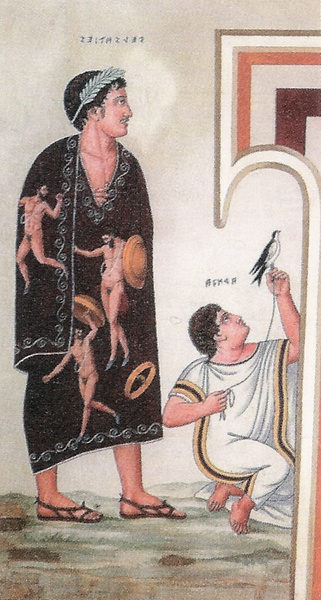
One of the longer-lasting fashions the Etruscans gave to antiquity was the toga, to them the trebenna. Worn over the left shoulder and leaving the right shoulder bare, it is seen in mid-6th-century BCE terracotta plaques from Cerveteri where a king wears a purple one. Other figures wear one, this time decorated with a red border, in the Tomb of the Augurs at Tarquinia (c. 520 BCE). The Romans would adopt the toga, albeit making it a little longer and varying its folds, as a badge of distinction for the patrician class, keeping the red or purple border (derived from the Tyrian purple dye) and reserving the all-purple robe for emperors and those basking in the glory of a Roman triumph. The Etruscans, however, seemed to have been a little more democratic with their clothing, for the toga, usually all white, is seen in tomb paintings worn by musicians in, for example, Tarquinia.
Footwear
A feature of the Etruscans is that they wore shoes, seemingly more frequently than their Greek counterparts. Pointed shoes, for both men and women, are especially common in art; again an influence from Ionia and the Near East. Those in Tarquinia's Tomb of the Augurs and Tomb of the Baron (c. 510 BCE) look like a cross between boots and slippers and are green, red, or burgundy in colour. They widen at the front, then finish in a slightly raised point at the toes. Reaching up to the calf, they finish in a turnover split at the front. Similar types depicted on terracotta plaques have a long tongue and horizontal straps to fasten the boots around the heel and another tie that passes through an eyehole at the top of the boot.
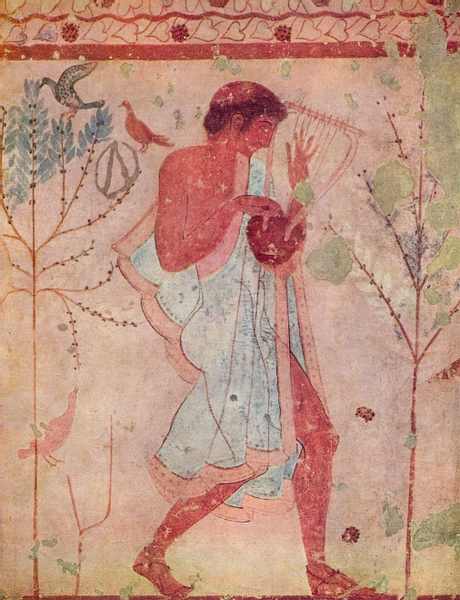
Less complicated shoes are worn by slaves which cover only the feet and the most typical is the simple sandal held on the foot by cross-straps. One can imagine sandals were worn by everyone in warmer weather as suggested by a pair appearing in the Tomb of the Stucco Reliefs at Cerveteri (last quarter 4th century BCE). These sandals have semicircular bands and a cord for the toes and appear at the end of the bed of the aristocratic occupant of the tomb. The Greeks called Etruscan sandals Tyrrhenica sandalia, and they are described as having high wooden soles with rather decadent gilded straps. Finds at Cerveteri and Bisenzio of surviving soles have metal studs, no doubt to make them last longer. In contrast, for wet weather, shoes and feet were sometimes protected by overshoes made from very thin sheet bronze.
